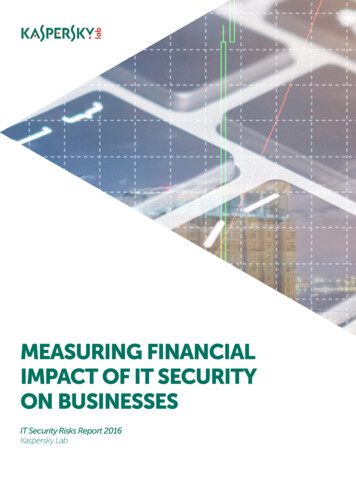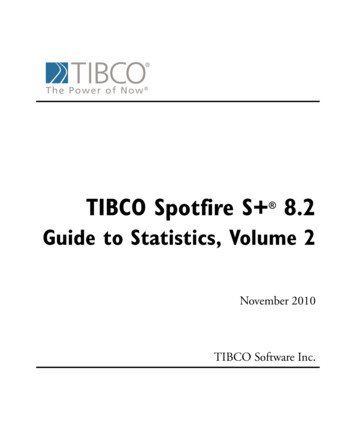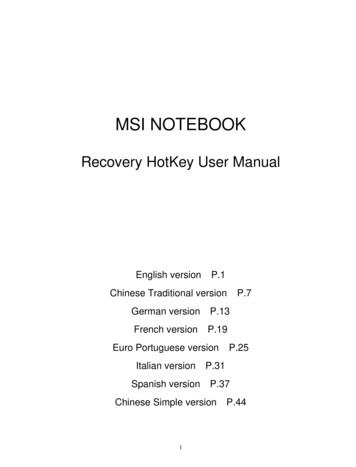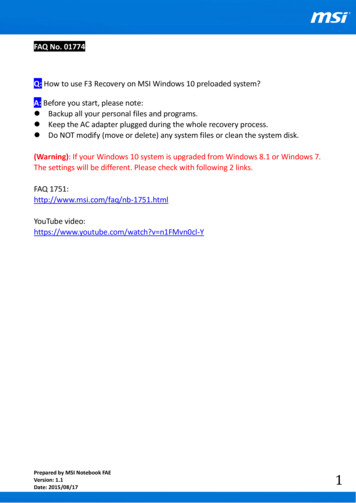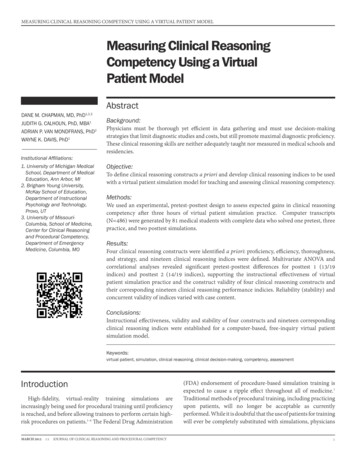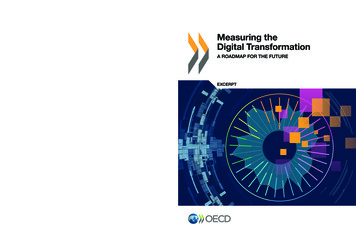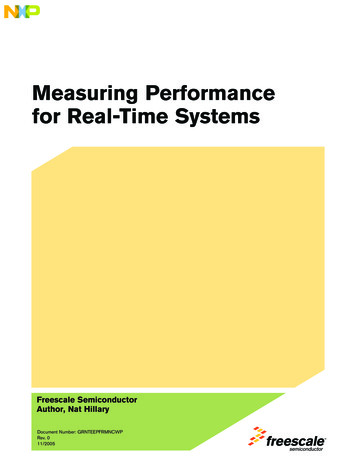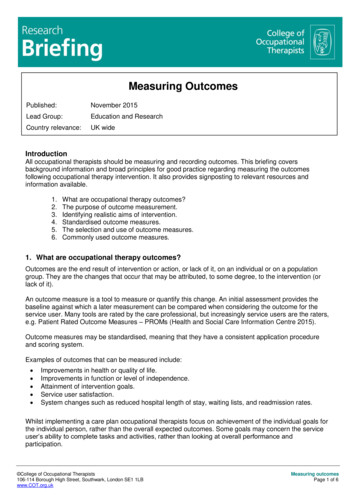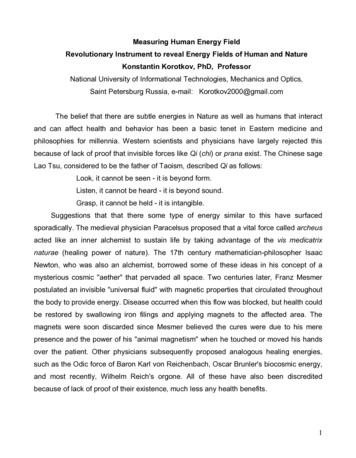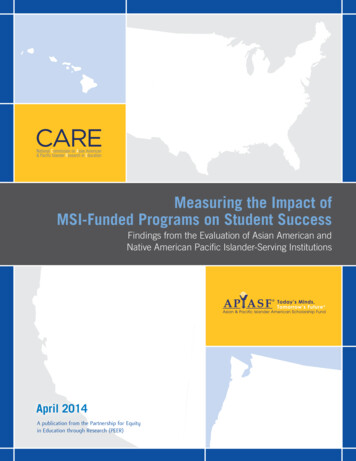
Transcription
Measuring the Impact ofMSI-Funded Programs on Student SuccessFindings from the Evaluation of Asian American andNative American Pacific Islander-Serving InstitutionsApril 2014A publication from the Partnership for Equityin Education through Research (PEER)Measuring Institutional Performance 1
Connecting Researchto Policy and PracticeThis report was made possible by a collaborative effort between the National Commissionon Asian American and Pacific Islander Research in Education (CARE), the Asian & PacificIslander American Scholarship Fund (APIASF), and three campus partners—De AnzaCollege, City College of San Francisco, and South Seattle Community College—involved inthe Partnership for Equity in Education through Research (PEER). We are indebted to ourfunders—Kresge Foundation, Lumina Foundation, USA Funds, and Walmart Foundation—for their generous support for this endeavor.The authors of this report are Robert Teranishi, Margary Martin, Loni Bordoloi Pazich,Cynthia M. Alcantar, and Tu-Lien Kim Nguyen. Other contributors include Bach Mai DollyNguyen, Dina Maramba, Mary Yang, Jisun Yoo, Diqingyuzhen, Jossie Muñoz, and membersof the faculty and staff at PEER institutions.
National CommissionMargarita BenitezExcelencia in EducationEstela Mara BensimonUniversity of Southern CaliforniaCarrie BillyAmerican Indian HigherEducation ConsortiumMichelle Asha CooperInstitute for HigherEducation PolicyA. Gabriel EstebanSeton Hall UniversityAntonio FloresHispanic Association of Collegesand UniversitiesLarry GriffithUnited Negro College FundJ.D. HokoyamaLeadership Education for AsianPacifics, Inc.Neil HorikoshiAsian & Pacific IslanderAmerican Scholarship FundShirley HuneUniversity of WashingtonParag MehtaU.S. Department of LaborDon NakanishiUniversity of California,Los AngelesKawika RileyOffice of Hawaiian AffairsDoua ThorWhite House Initiative on AsianAmericans and Pacific IslandersRobert UnderwoodUniversity of GuamCARE Research TeamRobert TeranishiPrincipal InvestigatorTu-Lien Kim NguyenResearch AssociateJisun YooResearch AnalystMargary MartinPrincipal AnalystJossie MuñozResearch AssociateDiqingyuzhenResearch AnalystLoni Bordoloi PazichResearch AssociateBach Mai Dolly NguyenResearch AssociateCynthia M. AlcantarResearch AssociateMary YangResearch AnalystResearch Advisory GroupMitchell ChangUniversity of California,Los AngelesJulie J. ParkUniversity of Maryland,College ParkCaroline Sotello Viernes TurnerCalifornia State University,SacramentoDina C. MarambaState University of New York,BinghamtonOiyan PoonLoyola University ChicagoRican VueUniversity of California,Los AngelesEditorial TeamKatie Tran-LamAsian & Pacific IslanderAmerican Scholarship FundNora ScullinAsian & Pacific IslanderAmerican Scholarship FundTia T. GordonTTG PARTNERS1
ContentsExecutive Summary. . . . . . . . . . . . . . . . . . . . . . . . . . . . . . . . . . . . . . . . . . . . . . . . . . . . . 3Preface. . . . . . . . . . . . . . . . . . . . . . . . . . . . . . . . . . . . . . . . . . . . . . . . . . . . . . . . . . . . . . . 6Introduction . . . . . . . . . . . . . . . . . . . . . . . . . . . . . . . . . . . . . . . . . . . . . . . . . . . . . . . . . . 8Context for the Study. . . . . . . . . . . . . . . . . . . . . . . . . . . . . . . . . . . . . . . . . . . . . . . . . . . . . . . . . . . . . . . . . . 8Purpose of the Report . . . . . . . . . . . . . . . . . . . . . . . . . . . . . . . . . . . . . . . . . . . . . . . . . . . . . . . . . . . . . . . . 10MEASURING INSTITUTIONAL PERFORMANCE. . . . . . . . . . . . . . . . . . . . . . . . . . . . . . . . . . . . 12Analytic Framework for Examining the Impact of the MSI Program on Institutional Performance. . . . . . . . . . . . 12The Evaluation of AANAPISI-Funded Programs. . . . . . . . . . . . . . . . . . . . . . . . . . . . . . . . . . . . . . . . . . . . . . . 12Our Measures of Student Success. . . . . . . . . . . . . . . . . . . . . . . . . . . . . . . . . . . . . . . . . . . . . . . . . . . . . . . . 13DE ANZA COLLEGE . . . . . . . . . . . . . . . . . . . . . . . . . . . . . . . . . . . . . . . . . . . . . . . . . . . . . . . 14Institutional Profile . . . . . . . . . . . . . . . . . . . . . . . . . . . . . . . . . . . . . . . . . . . . . . . . . . . . . . . . . . . . . . . . . . 14PEER Assessment of IMPACT AAPI Learning Communities . . . . . . . . . . . . . . . . . . . . . . . . . . . . . . . . . . . . . . 15CITY COLLEGE OF SAN FRANCISCO . . . . . . . . . . . . . . . . . . . . . . . . . . . . . . . . . . . . . . . . . . . 20Institutional Profile . . . . . . . . . . . . . . . . . . . . . . . . . . . . . . . . . . . . . . . . . . . . . . . . . . . . . . . . . . . . . . . . . . 20PEER Assessment of AANAPISI STEM. . . . . . . . . . . . . . . . . . . . . . . . . . . . . . . . . . . . . . . . . . . . . . . . . . . . . 21SOUTH SEATTLE COMMUNITY COLLEGE. . . . . . . . . . . . . . . . . . . . . . . . . . . . . . . . . . . . . . . . 24Institutional Profile . . . . . . . . . . . . . . . . . . . . . . . . . . . . . . . . . . . . . . . . . . . . . . . . . . . . . . . . . . . . . . . . . . 24PEER Assessment of the Learning Communities. . . . . . . . . . . . . . . . . . . . . . . . . . . . . . . . . . . . . . . . . . . . . . 25PROJECTIONS FOR CAMPUS-WIDE IMPACT . . . . . . . . . . . . . . . . . . . . . . . . . . . . . . . . . . . . . 28Gap Analysis for Scaling Up Programmatic Efforts . . . . . . . . . . . . . . . . . . . . . . . . . . . . . . . . . . . . . . . . . . . . 28Campus-Wide Impact on Student Outcomes. . . . . . . . . . . . . . . . . . . . . . . . . . . . . . . . . . . . . . . . . . . . . . . . . 29Lessons Learned and Looking Ahead. . . . . . . . . . . . . . . . . . . . . . . . . . . . . . . . . . . . . . . 31Implications for Practitioners . . . . . . . . . . . . . . . . . . . . . . . . . . . . . . . . . . . . . . . . . . . . . . . . . . . . . . . . . . . 33Implications for Policymakers. . . . . . . . . . . . . . . . . . . . . . . . . . . . . . . . . . . . . . . . . . . . . . . . . . . . . . . . . . . 34Technical Appendix . . . . . . . . . . . . . . . . . . . . . . . . . . . . . . . . . . . . . . . . . . . . . . . . . . . . 35Data Sources. . . . . . . . . . . . . . . . . . . . . . . . . . . . . . . . . . . . . . . . . . . . . . . . . . . . . . . . . . . . . . . . . . . . . . . 35Preparation of the Comparison Groups: Propensity Score Matching. . . . . . . . . . . . . . . . . . . . . . . . . . . . . . . . . 35Data Analysis Procedure. . . . . . . . . . . . . . . . . . . . . . . . . . . . . . . . . . . . . . . . . . . . . . . . . . . . . . . . . . . . . . . 38Recruitment Strategies and Selection Bias. . . . . . . . . . . . . . . . . . . . . . . . . . . . . . . . . . . . . . . . . . . . . . . . . . 38Endnotes. . . . . . . . . . . . . . . . . . . . . . . . . . . . . . . . . . . . . . . . . . . . . . . . . . . . . . . . . . . . . 412 Measuring the Impact of MSI-Funded Programs on Student Success
Executive SummaryThis report shares findings from a three-year longitudinal study of three Asian American andNative American Pacific Islander-Serving Institutions (AANAPISIs)—one of the newest minorityserving institution (MSI) designations—and provides evidence for the impact of federally-fundedcampus programs on persistence, degree attainment, and transfer to four-year institutions forlow-income Asian American and Pacific Islander (AAPI) students. This report demonstrates theimportant role of inquiry in enhancing the capacity-building efforts of institutions that servedisproportionately high concentrations of low-income minority students.For each campus, we studied the impact of grant-funded programs that were either new or modifiedinterventions with explicit goals to address challenges that the campuses identified as barriers to studentsuccess. We utilized a research design that enabled us to compare AAPI students in AANAPISI-funded programs(participant) to a comparable group of AAPI students who did not participate in the AANAPISI-funded program(comparison group). The analysis was based on cross-sectional and longitudinal cohort data that containinformation on student demographics, course-taking behavior, and course outcomes. The metrics for evaluatingstudent outcomes were aligned with the stated goals of each program’s intervention: Short-Term Outcomes: transition from developmental to college level courses, credit accumulation, andcourse performance (i.e., grade point average) Long-Term Outcomes: persistence from one academic term to the next, degree attainment, and transferfrom two- to four-year institutionsKey FindingsBelow are descriptions of each AANAPISI-funded intervention and the findings associated with each campus.De Anza College – IMPACT AAPIDe Anza’s Initiatives to Maximize Positive Academic Achievement and Cultural Thriving among AAPI (IMPACTAAPI) developed their first AAPI-focused learning community, Readiness and Success in College-Level English (LinC).This learning community paired a developmental English reading and writing course that is two levels below collegelevel English with a college-credit bearing Asian American literature course. This learning community included:comprehensive wrap-around support services, including an embedded counselor providing services for students in andout of class; culturally-relevant, critical, and engaged pedagogies; and culturally-relevant, critical, and civic curriculum.Key findings for our analysis of De Anza’s IMPACT AAPI learning communities: Students in the IMPACT AAPI learning community were more likely than the comparison group to transitionfrom developmental to college-level English. Compared to the comparison group, students in the IMPACT AAPI learning community passed theircollege-level English course, and accomplished the transition in less time. Students in the IMPACT AAPI learning communities were more likely than the comparison group to earnassociate’s degrees.Executive Summary 3
City College of San Francisco – AANAPISI STEM ProgramBoth a program and a dedicated site, the AANAPISI STEM program is an academic space that provides asupportive community and a variety of targeted services, including tutoring and study groups, supplementalinstruction, priority registration for impacted STEM classes, internship and research opportunities, and specialevents for students in the program. Support also includes dedicated counselors, specialized tutoring, additionalcore course sections, and a book loan program. The services offered were determined by a group of faculty andstaff who were interested in infusing culturally-responsive approaches to serving low-income AAPI students.Key findings for our analysis of City College of San Francisco’s AANAPISI STEM program: AANAPISI STEM program students attempted more academic credits per term than the comparison group,which shortened their time to completion. Compared to the comparison group, AANAPISI STEM program students enrolled in more academicallyrigorous coursework. AANAPISI STEM program students had a higher transfer rate to four-year institutions and transferred infewer terms compared to the comparison group.South Seattle Community College – Learning CommunitiesSSCC chose to use their AANAPISI funding to pilot learning communities, as their data indicated that studentsin developmental education struggled to transition to college-level coursework. This trend was particularlypronounced among low-income AAPI students who tended to be English Language Learners. The AANAPISIfunded learning communities featured developmental coursework linked to a college success course, as wellas access to tutoring and mentoring from peer navigators. Counselors taught the college success course andcovered topics such as time management and study skills. Counselors also worked closely with faculty teachingdevelopmental education to enhance curricula, ensure the materials and assignments in each linked coursereinforce one another, manage the peer navigators, and follow up with students outside of class.Key findings for our analysis of South Seattle Community College’s AANAPISI-funded learning communities: Learning community participants were more likely than the comparison group to transition fromdevelopmental to college-level courses. Compared to the comparison group, students in the AANAPISI-funded learning communities had a higherrate of persistence in the term following the intervention. Learning community participants were more likely than the comparison group to graduate with anassociate’s degree or certificate.Projections for Campus-Wide ImpactA primary goal of the AANAPISI program is to afford campuses an opportunity to experiment with practicesthat help students reach their full degree-seeking potential. For each campus, we conducted analysis to estimatethe potential for larger, campus-wide efforts to bring AANAPISI-funded programs to scale. We began with a gapanalysis to identify the number of students served by these programs and the number of students who met the samequalifications for participating in the program. For the latter group of students, we estimated the numerical increasesin short-term and long-term outcomes for AAPI students at the campus level.4 Measuring the Impact of MSI-Funded Programs on Student Success
Across the three campuses, there is great potential for bringing programs to scale. For the three campusesin the aggregate, there were an additional 2,903 AAPI students who could gain access to AANAPISI-fundedprogramming (872 at De Anza College, 671 at City College of San Francisco, and 1,360 at South SeattleCommunity College). If the AANAPISI-funded learning communities at De Anza College were brought to scale, we project 863students would pass developmental English, which is a 59 percent improvement. Scaling up the AANAPISI STEM program at the City College of San Francisco would result in 577 AAPISTEM students transferring to a four-year college, which is a 123 percent improvement. If AANAPISI-funded Clustered Learning Communities were brought to scale at South Seattle CommunityCollege, we estimate 1,312 would persist one term following developmental English or math, which is a 146percent improvement.Lessons Learned and Looking AheadBased on our findings, below are a set of recommendations for both practitioners and policymakers:Implications for Practitioners These interventions were successful because they were designed in response to a specific need or challenge.Programmatic goals were narrow and targeted, and the activities were all tied to maximizing the potential ofthe intervention. Establishing a culture of inquiry is critical for capacity-building efforts. This includes having institutionalresearchers as a part of the campus leadership team collaborating with faculty, staff, and administrators. Evidence of success should drive efforts to replicate and scale up programs. These findings should also beshared with a broader audience outside of the institution. The findings from assessment should be discussed widely between different constituents on campus togenerate strategic and thoughtful ways to address broader institutional objectives.Implications for Policymakers Money matters for MSIs – targeted investments can drive innovation, support institutional change, and helpraise degree attainment rates. Policymakers should consider ways to incentivize the scaling up of programs for which there is a measurableimpact of the MSI-funded interventions. In order for MSIs to reach their full potential they need support with assessment so they can betterunderstand and refine efforts to improve institutional performance. Government and foundations should invest in partnerships that generate innovative and effective practices;there is a critical opportunity to do this with MSIs.Executive Summary 5
PrefaceThrough generous support from the Kresge Foundation, Lumina Foundation, USA Funds,and Walmart Foundation, the National Commission on Asian American and Pacific IslanderResearch in Education (CARE) teamed up with the Asian & Pacific Islander AmericanScholarship Fund (APIASF) and three Asian American and Native American Pacific IslanderServing Institution (AANAPISI) campus partners—De Anza College, City College of SanFrancisco, and South Seattle Community College—to create the Partnership for Equity inEducation through Research (PEER).Major Components of PEERWith a goal of supporting AANAPISIs to more fullyrealize the degree-earning potential of Asian Americanand Pacific Islander (AAPI) students, PEER engagesin co-investigative action research with campusteams to identify promising practices, implementtargeted interventions, and mobilize key stakeholdersto support greater institutional effectiveness. PEERalso includes efforts to work with campus partnersto support AANAPISIs in the policy arena byincreasing the program’s visibility and its impacton the educational mobility of low-income AAPIstudents. Finally, PEER oversees the disseminationof APIASF scholarships at AANAPISIs, as well as thetracking of scholarship recipients and non-recipientsto examine the extent to which scholarships influencethe persistence, degree attainment, and transfer ratesof low-income AAPI students. This is the first studyThis report is the second in a series of reports thatshare results from PEER. Because the AANAPISIprogram is relatively new, it is critical for highereducation practitioners, community leaders, andpolicymakers to have accurate information onAANAPISI programs and the landscape of theseinstitutions. In this report, we share key findingsfrom our evaluation of AANAPISI-funded programs,which involved tracking the impact of funding on theinstitutional performance of three AANAPISIs thatwere part of the first group of institutions fundedin 2008. This research informs the work of campuspartners, as well as the broader effort to developevaluative tools for assessing the impact of minorityserving institutions (MSIs) on the success of lowincome students of color.Advance InstitutionalEffectiveness Co-Investigative ResearchMobilize Community forIncreased Support Cross-Campus CollaborativeAccelerate Student Success6 of its kind to examine low-income AAPI scholarshiprecipients at community colleges. Jointly Develop and Deploy Intervention Plan Promote Increased Investment in AANAPISIs Provide Scholarship Support Study Scholarship RecipientsMeasuring the Impact of MSI-Funded Programs on Student Success
AAPI Demography and Educational AttainmentThe United States is at a crossroads oftremendous demographic change. While thepopulation is growing, it is also changingsignificantly in its composition, and the AAPIpopulation is a significant factor in thesedemographic changes. In higher education,for example, AAPI enrollment grew five-foldbetween 1979 and 2009. While college enrollmentis projected to increase for all racial groups,AAPIs will experience a particularly highproportional increase of 35 percent over the nextdecade. With the remarkable growth amongAAPIs in higher education, it is important torecognize the shifting demographic makeup ofthe population with regard to its heterogeneity.The AAPI racial category consists of more than48 different ethnic groups that occupy positionsalong the full range of the socioeconomicspectrum, from the poor and under-privileged,to the affluent and highly-skilled.One of the most misunderstood aspects ofthe AAPI community pertains to educationalattainment. AAPI students vary widely in theirprogress through the educational pipeline, whichhas implications for their educational attainmentand outcomes. Access to higher educationremains a significant challenge for many AAPIstudents. Consider that 50 to 65 percent ofSoutheast Asian and 50 to 60 percent of PacificIslander adults (25 or older) have not enrolledin any form of postsecondary education. WhenAAPI students do attend college, there are alsonotable differences in the likelihood of
Islander American Scholarship Fund (APIASF), and three campus partners—De Anza College, City College of San Francisco, and South Seattle Community College—involved in the Partnership for Equity in Education through Research (PEER). We are indebted to our funders—Kresge Foundati

